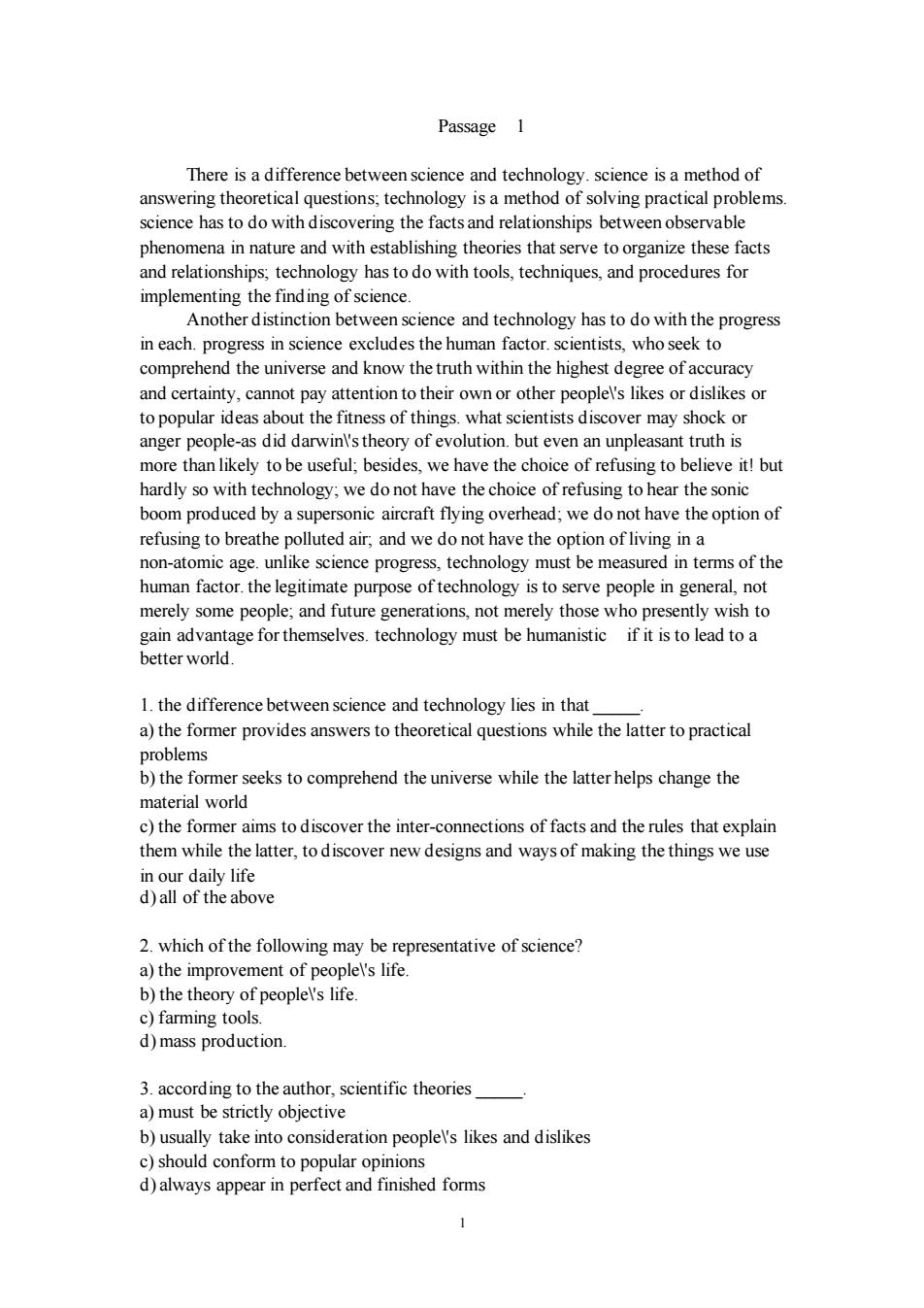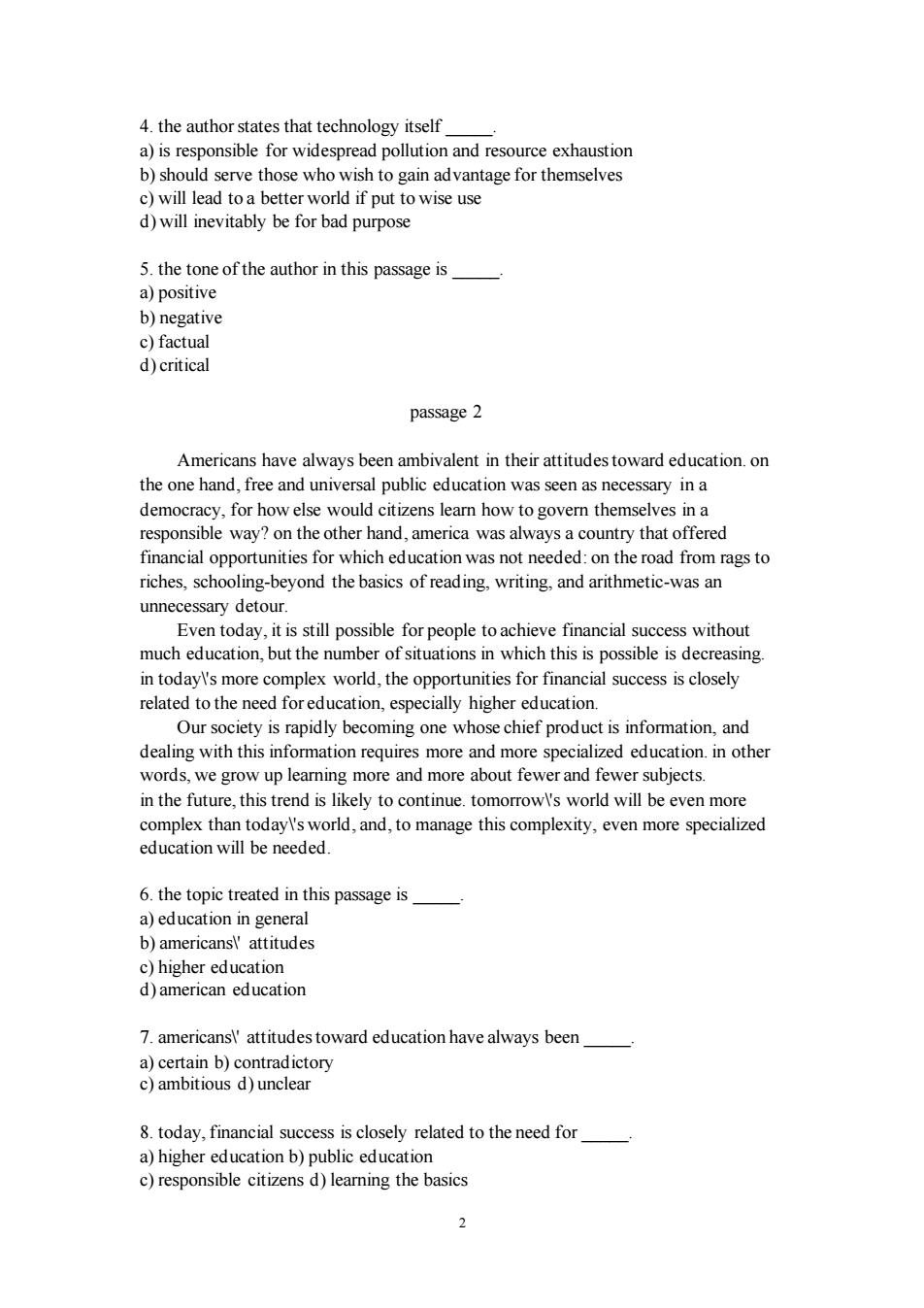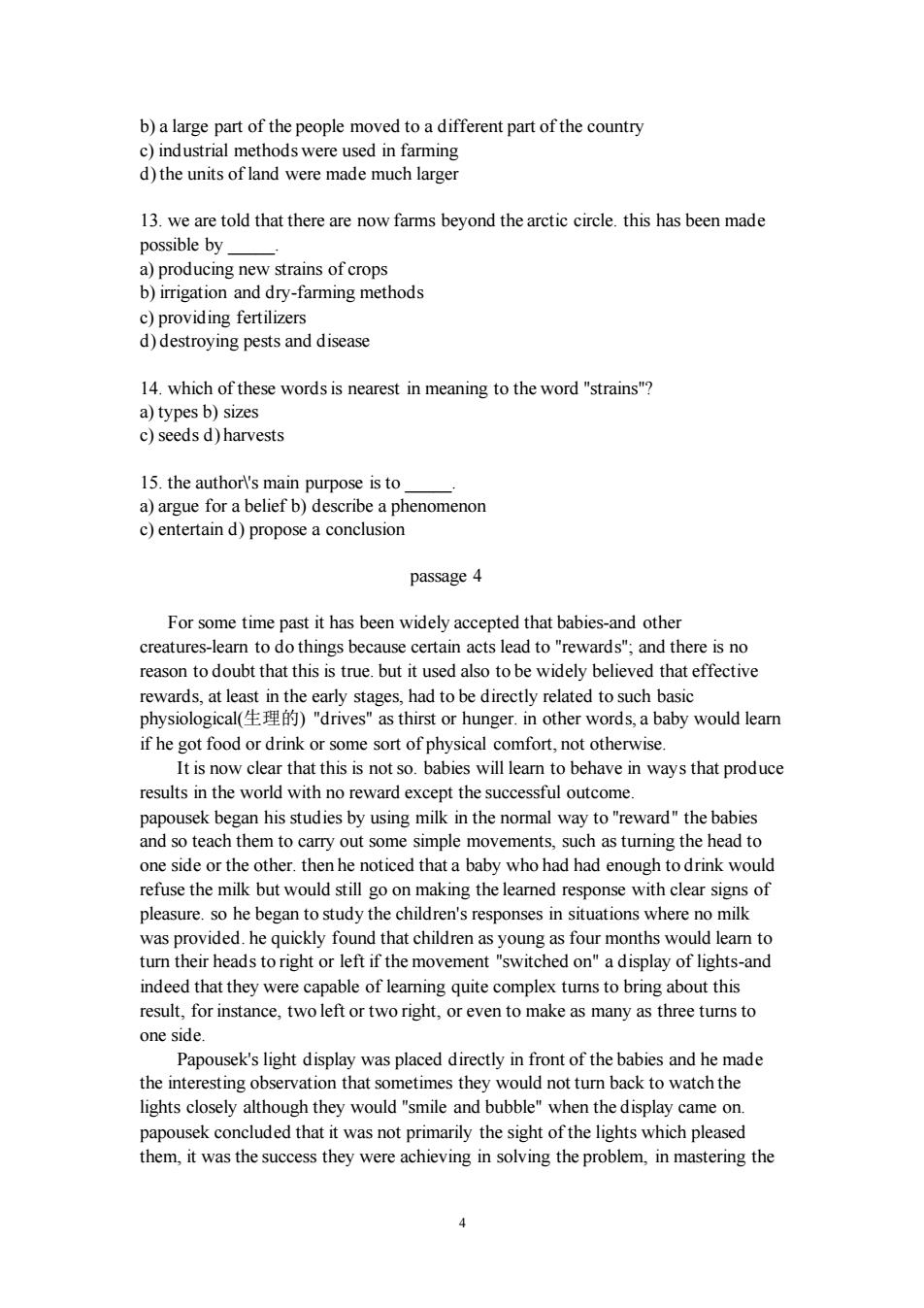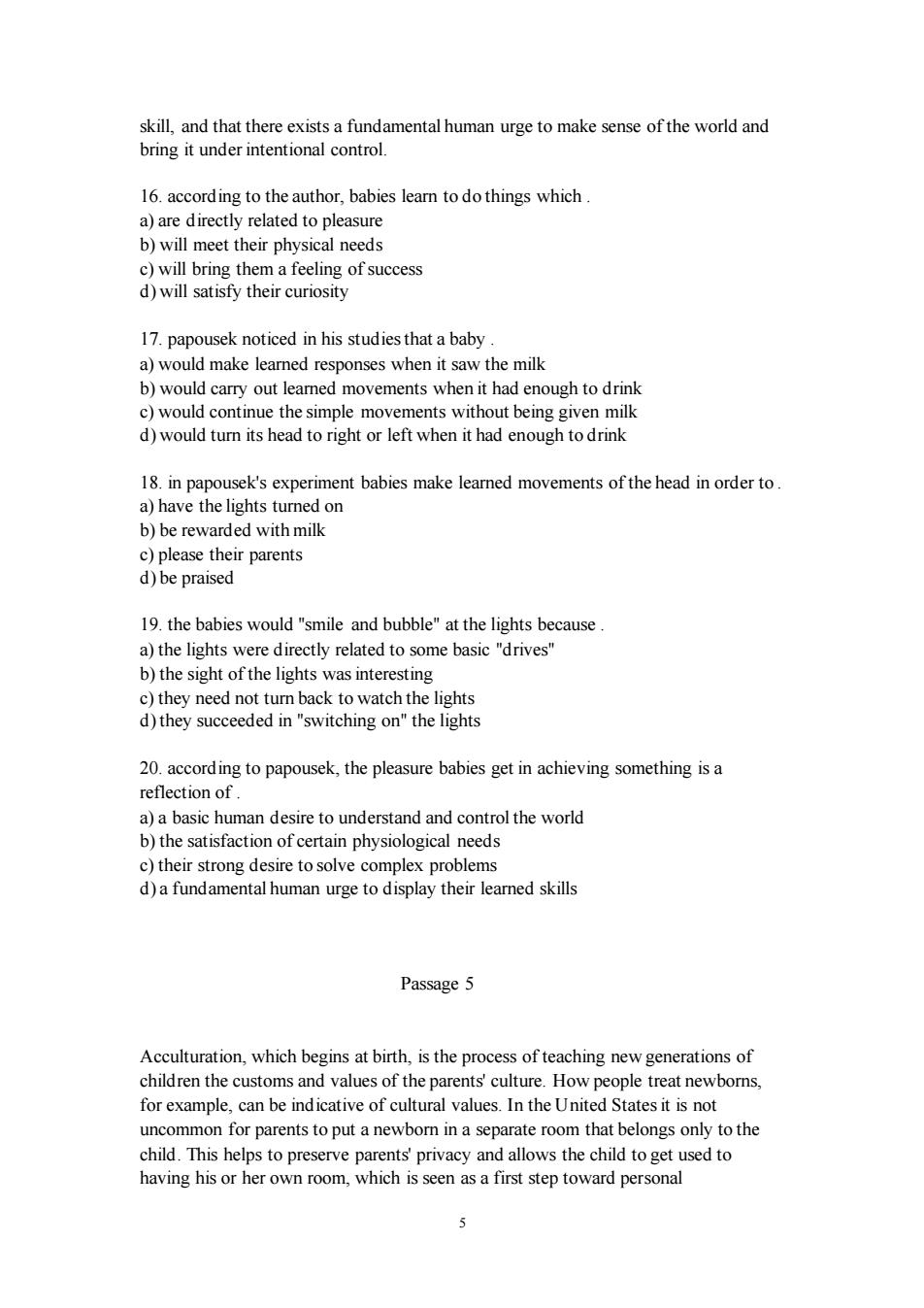
Passage I There is a difference between science and technology.science is a method of answering theoretical questions,technology is a method of solving practical problems. science has to do with discovering the facts and relationships between observable phenomena in nature and with establishing theories that serve to organize these facts and relations technology has todo with tools,techniques,and procedures for implementing the finding of science. Another distinction between science and technology has to do with the progress in each.progress in science excludes the human factor.scientists,who seek to comprehend the universe and know the truth within the highest degree of accuracy and certainty.cannot pay attention to their ownor other peo ple's likes or dislikes or to popular deas a t the fitness of things.what scientists discover may shock 0 anger people-as did darwins theory of evolution.but even an unpleasant truth is more than likely to be useful;besides,we have the choice of refusing to believe it!but hardly so with technology;we do not have the choice of refusing to hear the sonic boom produced by a supersonic aircraft flying overhead:we do not have the option of refusing to breathe polluted air,and we do not have the option of livin ina non-atomic age.unlike science progress,technology must be measured in terms of the human factor.the legitimate purpose of technology is to serve people in general,not merely some people;and future generations,not merely those who presently wish to advantage for themselves.technology must be humanistic if istod to 1.the difference betweenscience and technology lies in that a)the former provides answers to theoretical questions while the latter to practical problems b)the former seeks to comprehend the universe while the latter helps change the material world c)the fom tediver newdeigns and wavsof mint over the inter-connections of facts and the rules that explain in our daily life d)all of the above 2.which of the following may be representative of science? improvement of olel's life c)farming tools d)mass production. 3.according to the author,scientific theories a)must be strictly objective b)usually take ratior peoples likes and dislikes c)should conform to popular opinions d)always appear in perfect and finished forms
1 Passage 1 There is a difference between science and technology. science is a method of answering theoretical questions; technology is a method of solving practical problems. science has to do with discovering the facts and relationships between observable phenomena in nature and with establishing theories that serve to organize these facts and relationships; technology has to do with tools, techniques, and procedures for implementing the finding of science. Another distinction between science and technology has to do with the progress in each. progress in science excludes the human factor. scientists, who seek to comprehend the universe and know the truth within the highest degree of accuracy and certainty, cannot pay attention to their own or other people\'s likes or dislikes or to popular ideas about the fitness of things. what scientists discover may shock or anger people-as did darwin\'s theory of evolution. but even an unpleasant truth is more than likely to be useful; besides, we have the choice of refusing to believe it! but hardly so with technology; we do not have the choice of refusing to hear the sonic boom produced by a supersonic aircraft flying overhead; we do not have the option of refusing to breathe polluted air; and we do not have the option of living in a non-atomic age. unlike science progress, technology must be measured in terms of the human factor. the legitimate purpose of technology is to serve people in general, not merely some people; and future generations, not merely those who presently wish to gain advantage for themselves. technology must be humanistic if it is to lead to a better world. 1. the difference between science and technology lies in that _. a) the former provides answers to theoretical questions while the latter to practical problems b) the former seeks to comprehend the universe while the latter helps change the material world c) the former aims to discover the inter-connections of facts and the rules that explain them while the latter, to discover new designs and ways of making the things we use in our daily life d) all of the above 2. which of the following may be representative of science? a) the improvement of people\'s life. b) the theory of people\'s life. c) farming tools. d) mass production. 3. according to the author, scientific theories _. a) must be strictly objective b) usually take into consideration people\'s likes and dislikes c) should conform to popular opinions d) always appear in perfect and finished forms

4 the author states that technology itself tion and resource exhaustion c)will lead to a better world if put to wise use d)will inevitably be for bad purpose 5.the tone of the author in this passage is a)positive b)negative c)factual d)critical passage 2 Americans have always been ambivalent in their attitudestoward education.on the one hand,free and universal public education was seen as necessary ina democracy,for how else would citizens learn how to govern themselves in a responsible way?on the other hand,america was always a country that offered financial opportunities for which education was not needed:on the road from rags to riches,schooling-beyond the basics of reading.writing,and arithmetic-was an unnecessary detou Even today,it is still possible for people to achieve financial success without much education,but the number of situations in which this is possible is decreasing in todayIs more complex world.the opportunities for financial success is closely related to the need for education,especially higher education. Ours rapidly becoming one who se chief prod ct is information,and dealing with this information requires more and more specialized edu cation.in othe words.we grow up learning more and more about fewer and fewer subjects. in the future,this trend is likely to continue.tomorrowl's world will be even more complex than todavI's world and to manage this complexity.even more specialized education will be needed. 6.the topic treated in this passage is a)education in genera b)americans\'attitudes c)higher education d)american education 7.americans attitudes toward education have always been a)certain b) 8.today,financial success is closely related to the need for a)higher education b)public education c)responsible citizens d)learning the basics 2
2 4. the author states that technology itself _. a) is responsible for widespread pollution and resource exhaustion b) should serve those who wish to gain advantage for themselves c) will lead to a better world if put to wise use d) will inevitably be for bad purpose 5. the tone of the author in this passage is _. a) positive b) negative c) factual d) critical passage 2 Americans have always been ambivalent in their attitudes toward education. on the one hand, free and universal public education was seen as necessary in a democracy, for how else would citizens learn how to govern themselves in a responsible way? on the other hand, america was always a country that offered financial opportunities for which education was not needed: on the road from rags to riches, schooling-beyond the basics of reading, writing, and arithmetic-was an unnecessary detour. Even today, it is still possible for people to achieve financial success without much education, but the number of situations in which this is possible is decreasing. in today\'s more complex world, the opportunities for financial success is closely related to the need for education, especially higher education. Our society is rapidly becoming one whose chief product is information, and dealing with this information requires more and more specialized education. in other words, we grow up learning more and more about fewer and fewer subjects. in the future, this trend is likely to continue. tomorrow\'s world will be even more complex than today\'s world, and, to manage this complexity, even more specialized education will be needed. 6. the topic treated in this passage is _. a) education in general b) americans\' attitudes c) higher education d) american education 7. americans\' attitudes toward education have always been _. a) certain b) contradictory c) ambitious d) unclear 8. today, financial success is closely related to the need for _. a) higher education b) public education c) responsible citizens d) learning the basics

9.it can be inferred from the third paragraph that a)information is our only product b)education in the future will be specialized c)we are entering an age of information d)we are living in an age of information 10.which of the following is the best title for the passage? a)the history of amer education b)the need for specialized educatior c)the future of the american educational system. d)attitudes toward american education. passage 3 A growing world population and the discoveries of science may alter this patter of distribution in the future.as men slowly leam to master diseases,control floods. prevent famines,and stop wars,fewer people die every year,and in consequence the population of the world is steadily increasing.in 1925 there were about 2,000 million people in the world;by the end of the century there may well be over 4,000 million. When numbe rise the ust be fed.new landsr ust be brought under cultivation,or land already farmed made toyield larger crops.in some areas the accessible land is so intensively cultivated that it will be difficult to make it provide more food.in some areas the population is so dense that the land is parceled out in units too tiny to allow for much improvement in farming methods.were a large part of this farming population d awn off into industrialo upations,the land might be farmed much more productively by modem methods There is now a race for science,technology,and industry to keep the output of food rising faster than the number of people to be fed.new strains of crops are being developed which will thrive in unfavorable climates:there are now farms beyond the arctic circle in siberia and north america;irrigation and dry-far ning methods bring arid lands underthe plough,da hod back the great riv ensure wate for the fields in all seasons and to provide electric power for new industries;industrial chemistry provides fertilizers to suit particular soils,aeroplanes spray crops to destroy locusts and many plant diseases.every year some new means is devised to increase or to protect the food of the world. 11.the author says that the world population is growing because a)there are mar rich valleys and fertile pla b)the pattern of distribution is being altered c)people are living longer d)new land is being brought under cultivation 12.the author says that in densely populated areas the land might be more productively farmed if a)the plots were subdivided
3 9. it can be inferred from the third paragraph that _. a) information is our only product b) education in the future will be specialized c) we are entering an age of information d) we are living in an age of information 10. which of the following is the best title for the passage? a) the history of american education. b) the need for specialized education. c) the future of the american educational system. d) attitudes toward american education. passage 3 A growing world population and the discoveries of science may alter this pattern of distribution in the future. as men slowly learn to master diseases, control floods, prevent famines, and stop wars, fewer people die every year; and in consequence the population of the world is steadily increasing. in 1925 there were about 2,000 million people in the world; by the end of the century there may well be over 4,000 million. When numbers rise the extra mouths must be fed. new lands must be brought under cultivation, or land already farmed made to yield larger crops. in some areas the accessible land is so intensively cultivated that it will be difficult to make it provide more food. in some areas the population is so dense that the land is parceled out in units too tiny to allow for much improvement in farming methods. were a large part of this farming population drawn off into industrial occupations, the land might be farmed much more productively by modern methods. There is now a race for science, technology, and industry to keep the output of food rising faster than the number of people to be fed. new strains of crops are being developed which will thrive in unfavorable climates: there are now farms beyond the arctic circle in siberia and north america; irrigation and dry-farming methods bring arid lands under the plough, dams hold back the waters of great rivers to ensure water for the fields in all seasons and to provide electric power for new industries; industrial chemistry provides fertilizers to suit particular soils; aeroplanes spray crops to destroy locusts and many plant diseases. every year some new means is devised to increase or to protect the food of the world. 11. the author says that the world population is growing because _. a) there are many rich valleys and fertile plains b) the pattern of distribution is being altered c) people are living longer d) new land is being brought under cultivation 12. the author says that in densely populated areas the land might be more productively farmed if _. a) the plots were subdivided

b)a large part of the people moved toa different part of the country )ind ed in fa d)the units of lar d were made much larger 13.we are told that there are now farms beyond the arctic circle.this has been made possible by a)producing new strains of crops b)irrigation and dry-farming methods iding fertilizer 14.which of these words is nearest in meaning to the word "strains"? a)types b)sizes c)seeds d)harvests 15.the author's main c)entertain d)propose a conclusion passage 4 For some time past it has been widely accepted that babies-and other creatures-learn to do things because certain acts lead to "rewards":and there is no reason to doubt that thisi is true.but it used also to be widely believed that effective rewards,at e early stages,had to be directly related to such b physiological()"drives"as thirst or hunger.in other words,a baby would leam if he got food or drink or some sort of physical comfort,not otherwise. It is now clear that this is not so.babies will learn to behave in ways that produce results in the world with no reward except the successful outcome. papousek began his studies by using millk in the normal way to "reward"the babies and so teach them to carry out some simple movements,such as turning the head to one side or the other.then he noticed that a baby who hadhad enough to drink would refuse the milk but would still go on making the learned response with clear signs of pleasure.so he began to study the children's responses in situations where no milk ided t children as youn fo ld le ads toright or left if the movement"switched on"a display of lights-and indeed that they were capable of learning quite complex turns to bring about this result,for instance,two left or two right,or even to make as many as three turns to one side. usek's light displa was placed directly in front of the babies and he made the interesting observation that sometimes they d no o watch the lights closely although they would"smile and bubble"when the display came on. papousek concluded that it was not primarily the sight of the lights which pleased them,it was the success they were achieving in solving the problem,in mastering the
4 b) a large part of the people moved to a different part of the country c) industrial methods were used in farming d) the units of land were made much larger 13. we are told that there are now farms beyond the arctic circle. this has been made possible by _. a) producing new strains of crops b) irrigation and dry-farming methods c) providing fertilizers d) destroying pests and disease 14. which of these words is nearest in meaning to the word "strains"? a) types b) sizes c) seeds d) harvests 15. the author\'s main purpose is to _. a) argue for a belief b) describe a phenomenon c) entertain d) propose a conclusion passage 4 For some time past it has been widely accepted that babies-and other creatures-learn to do things because certain acts lead to "rewards"; and there is no reason to doubt that this is true. but it used also to be widely believed that effective rewards, at least in the early stages, had to be directly related to such basic physiological(生理的) "drives" as thirst or hunger. in other words, a baby would learn if he got food or drink or some sort of physical comfort, not otherwise. It is now clear that this is not so. babies will learn to behave in ways that produce results in the world with no reward except the successful outcome. papousek began his studies by using milk in the normal way to "reward" the babies and so teach them to carry out some simple movements, such as turning the head to one side or the other. then he noticed that a baby who had had enough to drink would refuse the milk but would still go on making the learned response with clear signs of pleasure. so he began to study the children's responses in situations where no milk was provided. he quickly found that children as young as four months would learn to turn their heads to right or left if the movement "switched on" a display of lights-and indeed that they were capable of learning quite complex turns to bring about this result, for instance, two left or two right, or even to make as many as three turns to one side. Papousek's light display was placed directly in front of the babies and he made the interesting observation that sometimes they would not turn back to watch the lights closely although they would "smile and bubble" when the display came on. papousek concluded that it was not primarily the sight of the lights which pleased them, it was the success they were achieving in solving the problem, in mastering the

bring it underintentional contro 16.according to the author,babies leam to dothings which a)are directly related to pleasure b)will meet their physical needs c)will bring them a feeling of success d)will satisfy their curiosity 17.papousek noticed in his studiesthat a baby a)would make learned responses when it saw the milk b)would carry out leamed movements when it had enough to drink c)would continue the simple movements without being given milk d)would turn its head to right or left when it had enough to drink sexperiment babies make leamed movements of the head in order to on b)be rewarded with milk c)please their parents d)be praised 19.the babies would"smile and bubble"at the lights because a)the lights were directly related to some basic"drives b)the sight of the lights was interesting c)they need not turn back to watch the lights d)they succeeded in"switching on"the lights 20.according to papousek,the pleasure babies get in achieving something is a a)a basic human desire to understand and control the world b)the satisfaction of certain physiological needs c)their strong desire to solve complex problems d)a fundamental human urge to display their learned skills Passage 5 Acculturation,which begins at birth,is the process of teaching new generations of children the and values of the.Ho peopl treat newboms for example can be indicative of cultural values.In the United States it is no uncommon for parents to put a newborn in a separate room that belongs only to the child.This helps to preserve parents'privacy and allows the child to get used to having his or her own room,which is seen as a first step toward personal
5 skill, and that there exists a fundamental human urge to make sense of the world and bring it under intentional control. 16. according to the author, babies learn to do things which . a) are directly related to pleasure b) will meet their physical needs c) will bring them a feeling of success d) will satisfy their curiosity 17. papousek noticed in his studies that a baby . a) would make learned responses when it saw the milk b) would carry out learned movements when it had enough to drink c) would continue the simple movements without being given milk d) would turn its head to right or left when it had enough to drink 18. in papousek's experiment babies make learned movements of the head in order to . a) have the lights turned on b) be rewarded with milk c) please their parents d) be praised 19. the babies would "smile and bubble" at the lights because . a) the lights were directly related to some basic "drives" b) the sight of the lights was interesting c) they need not turn back to watch the lights d) they succeeded in "switching on" the lights 20. according to papousek, the pleasure babies get in achieving something is a reflection of . a) a basic human desire to understand and control the world b) the satisfaction of certain physiological needs c) their strong desire to solve complex problems d) a fundamental human urge to display their learned skills Passage 5 Acculturation, which begins at birth, is the process of teaching new generations of children the customs and values of the parents' culture. How people treat newborns, for example, can be indicative of cultural values. In the United States it is not uncommon for parents to put a newborn in a separate room that belongs only to the child. This helps to preserve parents' privacy and allows the child to get used to having his or her own room, which is seen as a first step toward personal